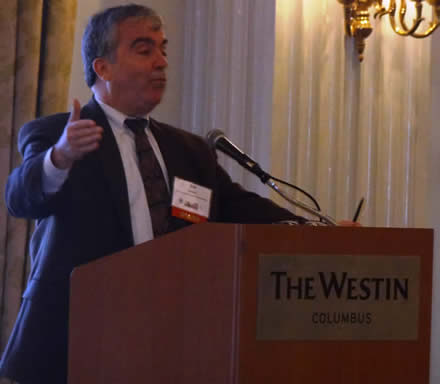
Rokakis: Help foreclosure victims who still live in blighted neighborhoods
A nationally recognized expert told advocates for urban revitalization that the forgotten victims of the foreclosure crisis are those homeowners who paid their mortgages and taxes on time and maintained their houses, only to see their property values plummet due to vacant and abandoned structures in the neighborhood.
Jim Rokakis, vice president of the nonprofit Western Reserve Land Conservancy and director of its Thriving Communities Institute, urged those attending the Revitalizing Ohio’s Vacant Properties conference to advocate for homeowners who remain in blighted neighborhoods but feel powerless to enact change.
Rokakis made the plea in his opening remarks at the Oct. 22-23 conference in Columbus.
“I don’t think I can overstate the importance of our collective efforts,” he told a crowd of nearly 300 people, including representatives of community development corporations, state and local governments, county land banks, financial institutions, regional planning agencies, housing services and private firms.
Rokakis added, “The people in this room are going to be the voice for people who don’t have a voice.”
Thriving Communities Institute has estimated that about 100,000 vacant and abandoned structures in Ohio need to be demolished. The organization has been pushing for more money to be set aside for demolition.
In 2008, Rokakis, then the Cuyahoga County treasurer, was the driving force behind the creation of the first county land bank in Ohio, the Cuyahoga County Land Reutilization Corp., known as the Cuyahoga Land Bank.
Since its establishment in 2011, Thriving Communities Institute has helped establish another 15 county land banks throughout Ohio. Rokakis said while the land banks, which acquire abandoned and tax-foreclosed properties and return them to productive use, “are not a panacea” for the blight caused by the foreclosure crisis, they have helped stabilize neighborhoods.
Rokakis praised Ohio Attorney General Mike DeWine for his move to set aside $75 million – part of the settlement of a lawsuit against five major mortgage servicers over foreclosure abuses and fraud, and unacceptable nationwide mortgage practices – for demolition. He said DeWine was one of the few state attorneys general to do so, and that in some states the settlement money went straight into the general fund.
“Our attorney general understood that the saddest victims of all were those who never dealt with these mortgage companies, who paid their bills on time,” Rokakis said, adding that Moving Ohio Forward, the demolition program DeWine created with part of the state’s settlement funds, “has been a game-changer.”
DeWine, who delivered the keynote address at the conference, said the goal was “to do something that would make an impact.” He said the fallout from the foreclosure crisis was evident in cities across the state, where he repeatedly saw well-kept homes with children playing in the yard next to houses that were falling apart.
The attorney general said when Rokakis made the case for demolition, he listened.
“One of the reasons I made the decision to spend the (settlement) money the way we did was Jim Rokakis,” he said.
DeWine said Moving Ohio Forward has made a difference, “but there are a lot of victims out there. We can’t make them all whole…It is about protecting Ohio families.”
Thriving Communities Institute co-sponsored the Revitalizing Ohio’s Vacant Properties conference with Greater Ohio Policy Center. In addition, several Thriving Communities staff members – Senior Policy Advisor Frank Ford, Director of Projects Sarah Ryzner and GIS and Conservation Planning Specialist Paul Boehnlein – made presentations during breakout sessions.
Ford said community leaders are now dealing with “a very harsh reality” in the wake of the depressed property values caused by the foreclosure crisis. He said it now takes $60,000 to $90,000 in subsidies to rehabilitate a home; for the same amount of money, a community could demolish six to nine houses. Either way, Ford said, “These costs represent an unprecedented shift of liability from the private sector to the public.”
Ryzner and Boehnlein, along with Lorain Mayor Chase Ritenauer, led a discussion on the need for cities to conduct surveys of their vacant properties in order to make the best decisions possible about the structures on those lots. Thriving Communities recently completed such a study for Lorain and is now in discussions with other Ohio cities about doing additional surveys.
Also speaking at the conference was Michigan-based researcher Nigel Griswold, who, in conjunction with the Center on Urban Poverty and Community Development at Case Western Reserve University, is completing a study that examines the effects of demolition on nearby property values and future foreclosures. The study was initiated by Thriving Communities Institute with additional funding from Cleveland City Council, Ohio Attorney General DeWine, the Cuyahoga Land Bank, the Franklin County Land Bank and land banks from Trumbull, Mahoning, Summit, Lucas, Montgomery, Hamilton and Stark counties.
